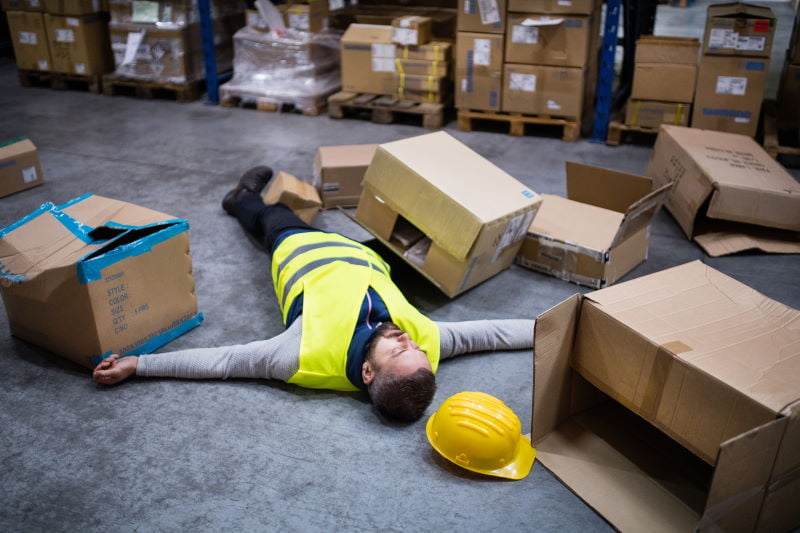According to the U S Bureau of Labor Statistics, the average injury and illness rate in the warehousing and storage industry is five per 100 workers. This equates to tens of thousands of cases yearly. When it comes to warehouse safety, you have to be proactive and always determine ways to mitigate risks and injuries in your facility. There are 10 effective methods to improve health and safety in your facility.
Slips, Trips And Falls
Slips, trips and falls are among the leading causes of injuries in general industry. Fortunately, they are almost always avoidable with good housekeeping practices. Avoid accumulation of trash dust and loose debris and walking areas. Frequent housekeeping and cleaning up spills when they occur is essential to avoid slips. Floors, passageways, Isles, and egress paths should be clean and clear of debris, obstructions, and clubs. At doorways and in high traffic areas consider installing walk-off mats to avoid slipping, especially in inclement weather.
Having an organized warehouse is also important. Ensure adequate shelving is installed and can support the weight of the storage material. Ensure aisles have proper overhead clearance to avoid head injuries. Materials should be stored flush with the shelving and not protrude into the walking areas.
When heavy or bulky items must be handled manually store these items at waist level. This will reduce the possibility of overexertion.
Secure items, such as ladders, that could fall causing a struck by injury.
Mitigate Fire Hazards
Fire hazards are frequently encountered in facilities. Improperly stored flammable and combustible liquids, open ignition sources and other hazards should be prevented. Avoid accumulation of items that can cause fires. Store flammables in fire lockers. Dispose of all combustible items in a metal container positioned far away from any ignition sources. Don’t store flammables near your forklift fleet.
Ensure doorways and exits are free of obstructions. Conduct monthly inspection of fire protection systems such as fire extinguishers, coal stations and emergency lights.
Some of injuries occur more frequently than others. For instance, slips trips and falls occur more frequently in general industry. According to OSHA, they cost 15% of all accidental deaths. One in six of all lost time incidents involved, slips, trips, and falls. This causes an average of 11 days away from work. You can mitigate these types of accidents by:
- Conducting inspections of your facility
- Performing detailed investigations for accidents and near misses
- Retraining your employees when conditions and work environment changes
Watch Out For Power Tools
Power tools and equipment account for over 400,000 injuries yearly. Most of these injuries are avoidable when safe work practices are followed. Some safe practices include:
- providing training to workers
- Inspecting tools before each use
- Wearing proper PPE when using tools
- Observing warning signs
- Verifying machine guards are in place
- Repairing defective equipment
All of these steps shared would be pointless if there was no formal process to assess their effectiveness. This could be daily, weekly, or monthly. Always follow the simple concept of plan, do, check, act, to stay ahead of any potential hazard. Have a checklist at hand and go over each inspection task thoroughly. Doing so will help to avoid overlooking potential hazards that may exist.
Don’t Overlook Employee Training
An important aspect that is often overlooked is employee training. Training should be one of the first items covered with new hires before working in a facility. Employees should be trained on safe work practices, PPE required for each activity, and how to identify unsafe conditions. There’s little use in having a detailed set of standards and rules if your employees have little or no knowledge of standards and rules. Using safety Sanders during training sessions is great, but they must be incorporated into daily activities for them to be effective. That means training and informing employees of the standards frequently.
It’s important to mark potential hazard with highly visible signs and labels. These signs serve the same purpose as safety precautions in that they are efficient reminders. If you’re changing a protocol, update the signage as soon as possible to keep staff abreast of the update in time. Post all safety expectations clearly, and in close proximity to the equipment they relate to. These signs serve as a constant visual reminder of inherent dangers and necessary safety precautions.
Ensuring safety in your warehouse is everyone’s responsibility. We all have a role to play. Go over any potential hazards, new protocols or non-routine tasks during weekly meetings. Take an extra step and recognize and reward behaviors that emphasize safety as a priority. This would further encourage employees to follow safe work practices, establish safe habits, and promote a safety culture. Follow these 10 basic steps to keep your workers safe and healthy in their working environment.


